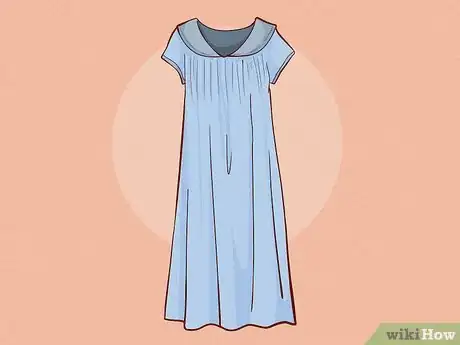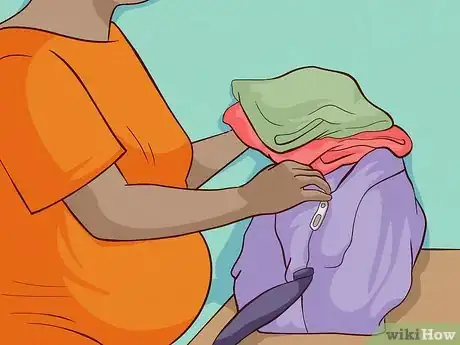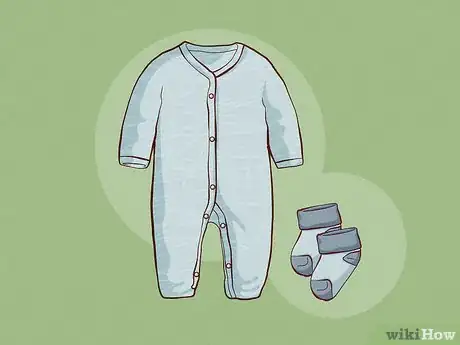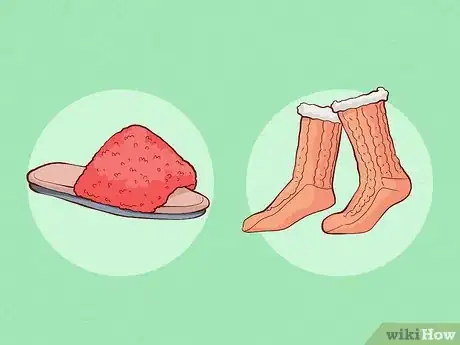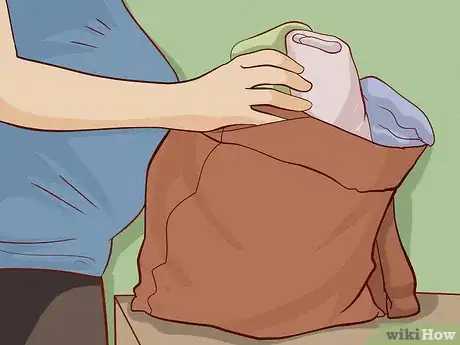This article was co-authored by Jennifer Butt, MD. Jennifer Butt, MD, is a board certified Obstetrician and Gynecologist operating her private practice, Upper East Side OB/GYN, in New York City, New York. She is affiliated with Lenox Hill Hospital. She earned a BA in Biological Studies from Rutgers University and an MD from Rutgers – Robert Wood Johnson Medical School. She then completed her residency in obstetrics and gynecology at Robert Wood Johnson University Hospital. Dr. Butt is board certified by the American Board of Obstetrics and Gynecology. She is a Fellow of the American College of Obstetricians and Gynecologists and a member of the American Medical Association.
This article has been viewed 260,059 times.
Once you learn that you're expecting a child, it's hard not to let your mind race ahead to the big day. These thoughts can cause a lot of anxiety, especially for first-time mothers. If you prepare your clothing ahead of time, you can simplify your list of things to do right before you go into labor. There are a few simple steps to making sure you have everything you need for your big day.
Steps
Dressing for a Hospital Birth
-
1Wear loose-fitting clothing for the journey to the hospital.[1] Wear a long dress, a long skirt, or pajamas. If it's warm outside, you don't need trousers. If it's cold, wear a pair of sweatpants. Try to find something that buttons down so that doctors can quickly remove your clothing if necessary. Once you arrive in the maternity ward, most hospitals will provide you with a nightgown to wear through the birth.
- If your water has already broken, you may just want to wear a long dress or skirt. Your trousers will become soaked with amniotic fluid before you get to the hospital. Alternately, wear a loose-fitting top and loose-fitting elastic pants, and use a sanitary napkin.
- If your water has not yet broken, you should be fine wearing jogging bottoms or pajamas.
-
2Know that you will be asked to change into a nightgown. In the end, if you are having your baby in a hospital, it does not matter what you are wearing before you arrive at the hospital in active labor. You will be asked to change into a hospital gown upon your arrival.[2] By this point, what you are wearing will be the last thing on your mind![3]Advertisement
-
3Try to wear undergarments suited to pregnancy. Cotton is best. Try to avoid underwiring and harsh straps in bras; you will be more comfortable if you wear elastic straps instead. It's best not to wear anything underneath a long dress.
- If you are expecting to go into labor at any moment, make sure that you are wearing old underwear. When your water breaks, your underwear will be ruined.
-
4Consider bringing your own nightgown. The hospital will provide you with one of their gowns to wear during labor, but you have the option to bring your own nightgown. You do not have to use the one the hospital provides for you. There are pros and cons to both options, but ultimately the choice is yours.
- Some women prefer to use the gown that the hospital provides because they don’t have to worry about getting it dirty. The gown will be stained with blood and other fluids during labor, and these may not come out in the wash.
- However, some women don't worry about this, and prefer to wear their own gown. You may feel most comfortable in your own gown, even if you buy it new and only wear it this one time. Consider whether your peace of mind is worth the price of a nightgown that you will only wear once.
- For long or stalled labors, your physician may ask you to walk the halls of the hospital to hurry things along. If you overheat easily, be sure that your nightgown is long enough for you to comfortably walk the halls without donning a robe. Some women become overheated during labor.
-
5Make sure your hair is comfortable and out of the way. A small ponytail, a simple braid, or even a messy bun should do the trick. You can also just keep your hair down if you don't mind it being in your face. If your hair is long, bring an elastic ponytail holder to tie it back. If your hair is short, an elastic headband can help keep hair out of your face. Most women sweat during heavy labor and delivery, and keeping the hair off of your face will make you that much more comfortable.
-
6If it's hot, wear loose, light-colored clothing, and nothing on your feet. It's okay to go barefoot in the hospital. You should be in light, loose, light-colored clothing that will keep you as cool as possible. If you start to get too hot, ask for cool water or ice chips.
Dressing for a Home Birth
-
1Wear loose clothing or nothing at all. Your comfort is your top priority. Avoid wearing anything that is tight around your stomach while you are having contractions—this will only increase the pain. Tight clothing can also keep you from finding a comfortable laboring position, and it may make it even harder to change into a nightgown if you are having strong contractions.
-
2If you decide to wear a nightgown, make sure it is breathable, loose, and comfortable. Make sure that it is not too long—knee-length is good. A long gown can become a problem during labor and delivery: it could get in the way of your fetal monitoring or the birth of the baby. Also, make sure that any gown you choose is not too short. The A-line dress is very popular for labor; momos, maxis, and nighties also work well.
- While you are still in the early stages of labor—before you actually start the delivery process—you may want to stay covered up so that you don't feel exposed.
- If you plan to breastfeed right after the birth, make sure that your nightgown buttons down the front at least enough to fully expose your breast.
-
3Consider wearing a large t-shirt that belongs to your partner. This may be loose and comfortable, and it can give you extra emotional support. Make sure that it's an old shirt, or something non-essential—there's a chance that you will stain or rip any clothing that you wear.
-
4Consider wearing a big t-shirt, a comfortable sports bra, and some loose bottoms. This will allow you to move around between contractions to maximize comfort and support effective breathing. As labor drags on, you may want to remove your bottoms to allow for examinations and fluid discharge.
- Wear something that you don't care too much about. Things could get messy.
- Remember that other people will be there. Consider how much skin you are comfortable showing.[4]
-
5Consider going nude. Many women prefer to go bare, especially for water births. You may find that you feel more comfortable and less restricted without clothing sticking to your sweaty body. You don't need to decide right away. You can always remove your gown or your bottoms as your labor progresses.[5]
Packing for a Hospital Stay
-
1Pack a "hospital bag" with everything you will need during your labor and hospital stay. Make a checklist of essential items, and pack your bag at least a week before your baby is due. You may not have time to pack when the time comes. Pack all the clothing you will need while you are at the hospital or birthing center. Planning ahead will help ensure that you are well-prepared when the time comes.
-
2Pack a bathrobe for after you have delivered your baby. Pack a robe that breathes well and will not cling to you. Cotton and terrycloth are popular fabric choices for postpartum robes. These fabrics will keep you warm, but they won't cling to your body too tightly.
- Avoid silk or satin robes. They are slippery, so they allow you to slide around while you are in bed. Hospital rooms can get cool at night, and the sheer material may not be enough to keep you warm.
- Avoid fleece and other heavy materials. You want to stay warm, but you don’t want to overheat.
-
3Don't over-pack items for the baby. It's best not to pack anything for the baby besides an outfit for wearing on the journey home and a car seat. The hospital will take care of the rest.
-
4Bring slippers and slipper socks. Choose slippers that will keep your feet warm and offer you good support. You may have to take walks during certain stages of your labor, so you want to stay warm and well-supported while walking. Avoid loose-fitting slippers that could lead you to slip or fall while you are walking.
- Slipper socks can be a lifesaver while you are confined to the bed during the early stages of your labor, as well as immediately after you give birth. They will keep your feet warm without being bulky or getting in the way.[6]
- Slipper socks are also great for keeping your feet warm during your delivery, as you will have to place your feet in stirrups. Most stirrups are fitted with covers, but they can still feel cold and uncomfortable.
-
5Remember to pack any toiletries that you will need. If you wear contacts, don’t forget your glasses and your contact solution. Bring your own toothbrush, toothpaste and your hair brush. If your labor is prolonged, you may end up walking down to the cafeteria or around the hospital, so bring anything that you will need to feel presentable.
- Most hospitals carry pads or tampons but consider bringing your own just in case. You don't need to use your own, but it can't hurt to have them.[7]
-
6Pack a set of clothes to wear out of the hospital or birthing center. Above all, make sure that this outfit is comfortable.
References
- ↑ Jennifer Butt, MD. Board Certified Obstetrician & Gynecologist. Expert Interview. 13 March 2020.
- ↑ Jennifer Butt, MD. Board Certified Obstetrician & Gynecologist. Expert Interview. 13 March 2020.
- ↑ http://forums.thebump.com/discussion/8209097/what-to-wear-during-labor-delivery
- ↑ http://offbeathome.com/2011/02/birth-dress
- ↑ http://pregnancy.about.com/od/maternityclothes/tp/whattowearinlabor.htm
- ↑ http://mylifeandkids.com/wear-your-socks-my-advice-on-labor-and/
- ↑ http://pregnancy.thefuntimesguide.com/2008/08/what_not_to_wear_birth.php
About This Article
When you’re in labor, you’ll want to dress comfortably for your ride to the hospital. Wear a long dress, long skirt, or pajamas. Try to find something that buttons down so doctors can easily help you out of your clothes. If it’s cold outside, you can also wear sweatpants unless your water’s already broken. Wear cotton underwear with elastic strips, which will be more comfortable than underwire. When you arrive at the hospital, you’ll be given a nightgown to wear during labor. If you’re having a home birth, wear a loose-fitting gown, an oversized t-shirt, or go naked. For more tips, including how to pack clothes for your hospital stay, read on.




